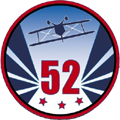The paragraphs that follow describe some of the aerobatic
figures that appear in aerobatic sequences. They show the Aresti
symbol, give the name of the figure, and provide a short description
of some of the things the judges look for in the figure.
THE SLOW ROLLThe Slow Roll requires that the aircraft roll without changing its
flight path. Judges will deduct points if the aircraft changes direction
in the roll, pitches up, or down, or changes rate of roll during the
maneuver.
THE LOOPA loop requires the competitor to fly a perfect circle in the sky regardless
of wind conditions. Judges will deduct for variations in the radius of
the loop and for changes in roll or in heading.
THE COMPETITION TURNThe competition turn requires the pilot to roll on heading to a
bank of at least sixty degrees, immediately begin a constant rate
change of heading without climbing or descending, stop after 90,
180, 270, or 360 degrees of turn, then roll on heading to level flight.
Judges deduct for inadequate bank, changes in rate of turn, climbing or
descending, and finishing off-heading.
THE SPINThe spin is a controlled maneuver in which the airplane
essentially falls downward while rolling and yawing at the same time.
Judges look for the nose and a wing to drop together, at the same
time, in the entry to the spin. They look for a clean vertical down line
after an exact number of quarter-rotations.
THE IMMELMANThe Immelman is a half-loop up followed immediately by a roll to
upright. The half loop up must have constant radius. The roll must
occur on a level line without delay after the half loop up.
THE HALF-CUBANThe Half-Cuban requires a five-eighths loop of constant radius.
The pilot must draw a forty-five degree line and center a roll to
upright on that line. Judges deduct for changes in radius, steep or
shallow lines, and rolls not centered on the line.
THE GOLDFISHFor a goldfish the competitor flies two forty-five degree lines connected
by a three-quarter loop. Any rolls must be centered on the lines. The
loop must have a constant radius.
THE WEDGEThe wedge has a vertical line and a forty-five degree line. Judges
deduct if the airplane is not vertical. If the airplane is slightly on its
belly they call it “positive.” If it is slightly on its back they call it
“negative.”
THE HAMMERHEADIn the United States we call this a “hammerhead.” Elsewhere it’s
described as a “stall turn.” The competitor flies straight up until
the plane slows nearly to a stop, then turns the plane on the yaw-axis,
with the rudder, and flies straight down. Judges deduct points if the
plane rolls or pitches during the turn.
THE SNAP ROLLA snap roll is a very fast roll caused by rapid change in pitch and
yaw, not by the ailerons as in a slow roll. Watch to see the nose move
up abruptly just before the rotation begins.
INVERTED FLIGHTInverted flight: The Aresti symbol will show a dotted line
whenever pilots must push the nose away from them to maintain the
flight path. A "push" forces the pilot out of the seat and into
the restraining straps.
THE ROLLING TURNA Rolling Turn will have one or more rolls integrated with the turn.
The rolls may be inside, in the same direction of the turn; outside, in
the opposite direction of the turn; or alternating inside and outside.
The rate of turn and the rate of roll must be constant. Both the turn
and the rolls must end at the same time after 90, 180, 270, or 360
degrees of heading change.
THE POINT ROLLPoint roll: Rolls may contain hesitations, or “points.” A two
indicates hesitations every half roll. A four every quarter roll, and an
eight every eighth roll. The pilot must pause the same amount of
time at each point and move between points with a constant roll rate.
The points should look like the ticking of a clock.
THE TAIL SLIDEIn a Tail Slide the airplane will briefly fly backward. The
competitor flies a vertical line up until gravity begins to pull the
airplane back down tail-first. The pilot must cause the plane to flip
nose to tail wheels-down (positive) or wheels-up (negative) after
sliding at least one-half the length of the fuselage. The pilot must fly
a vertical line down before resuming level flight.
THE NEGATIVE SNAP ROLLA Negative Snap Roll is much like the positive snap roll described
earlier, only watch for the nose to move downward (toward the
wheels) rather than upward. The nose will move abruptly before the
onset of a very rapid roll.

